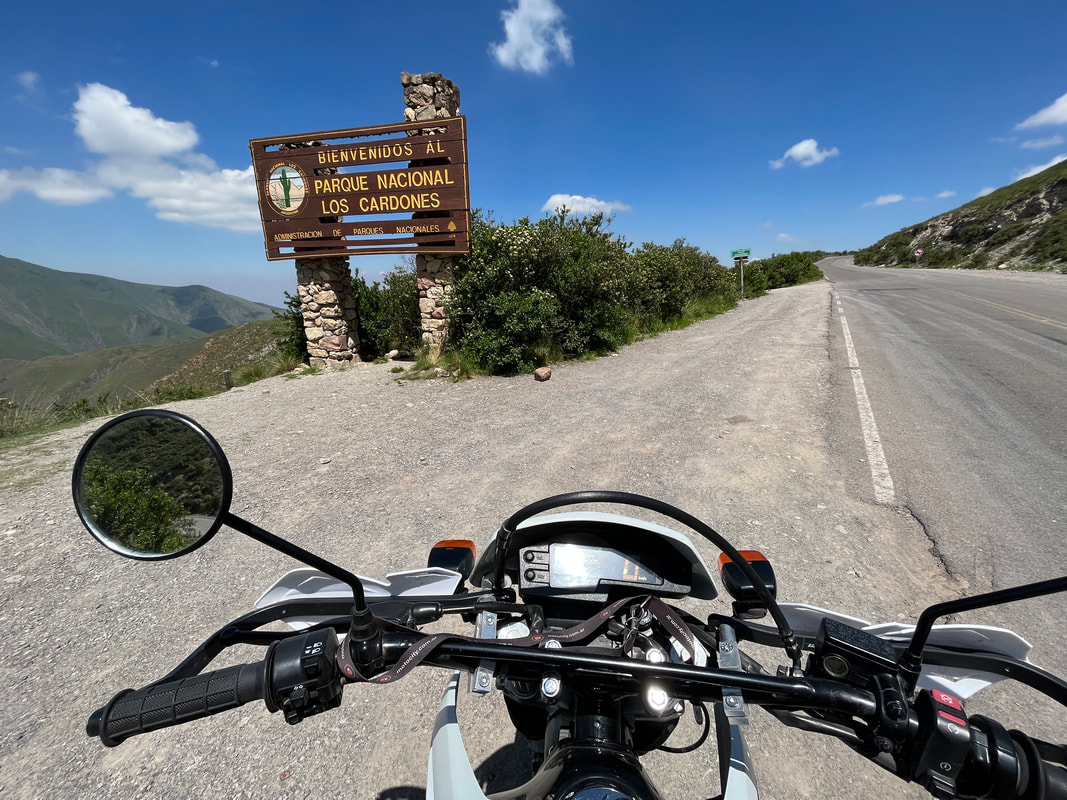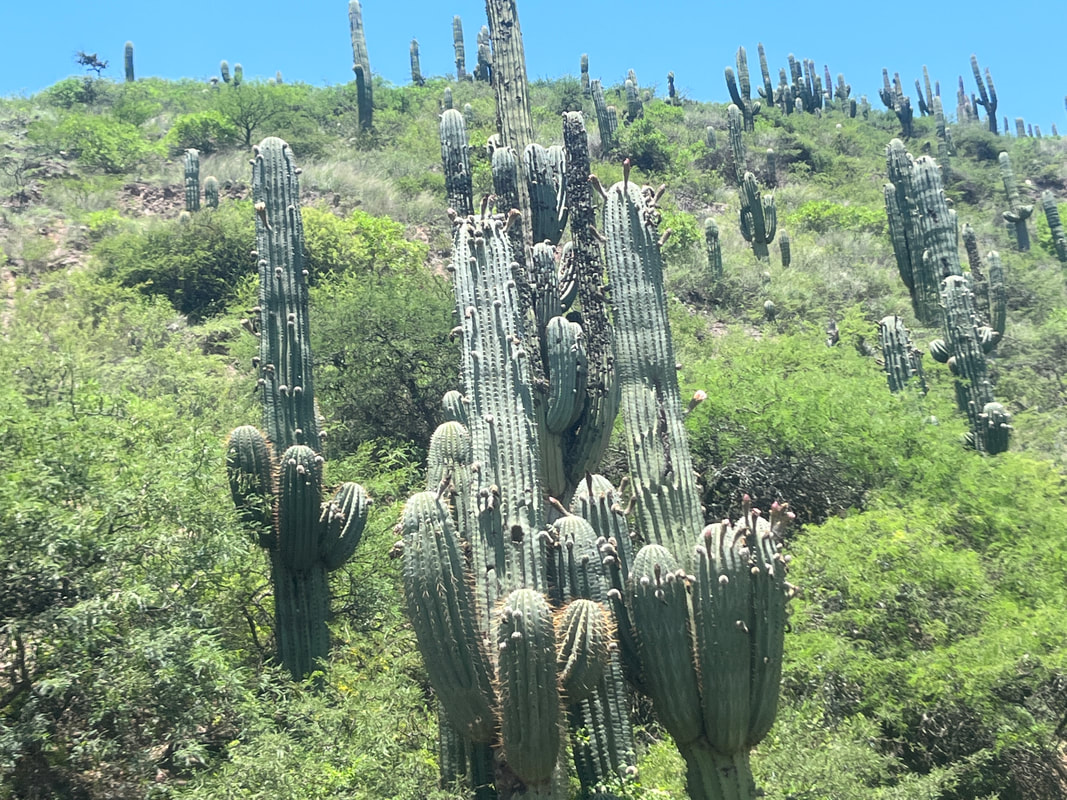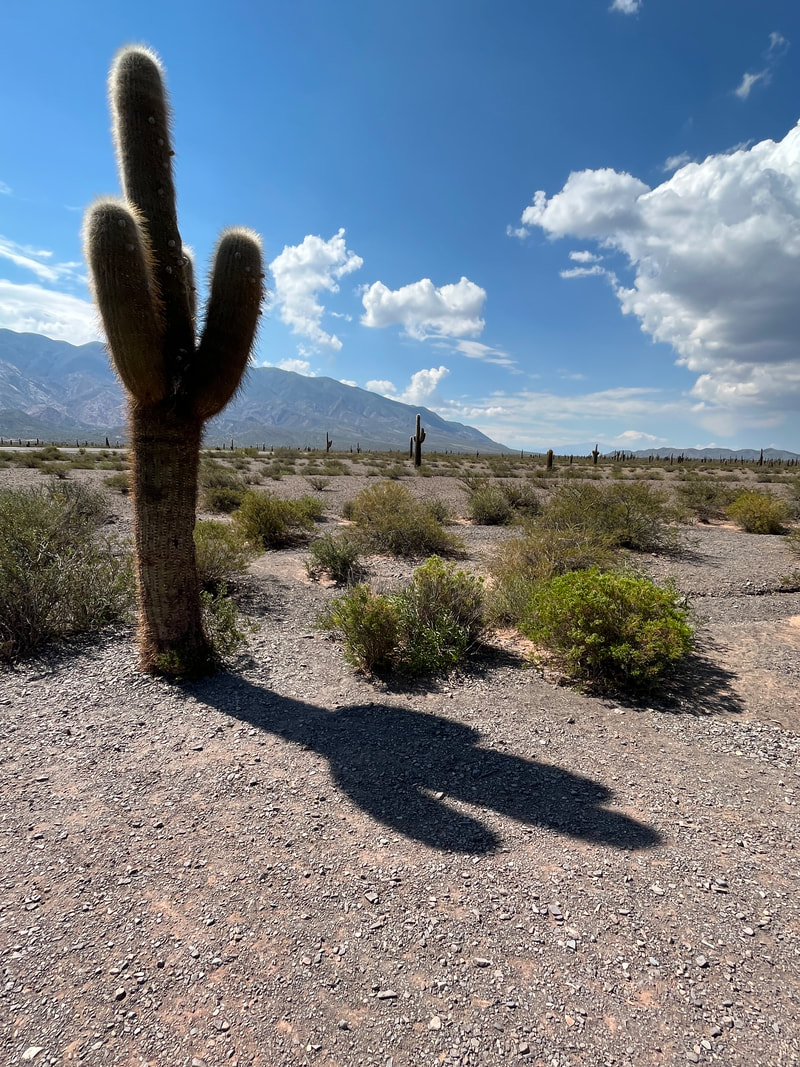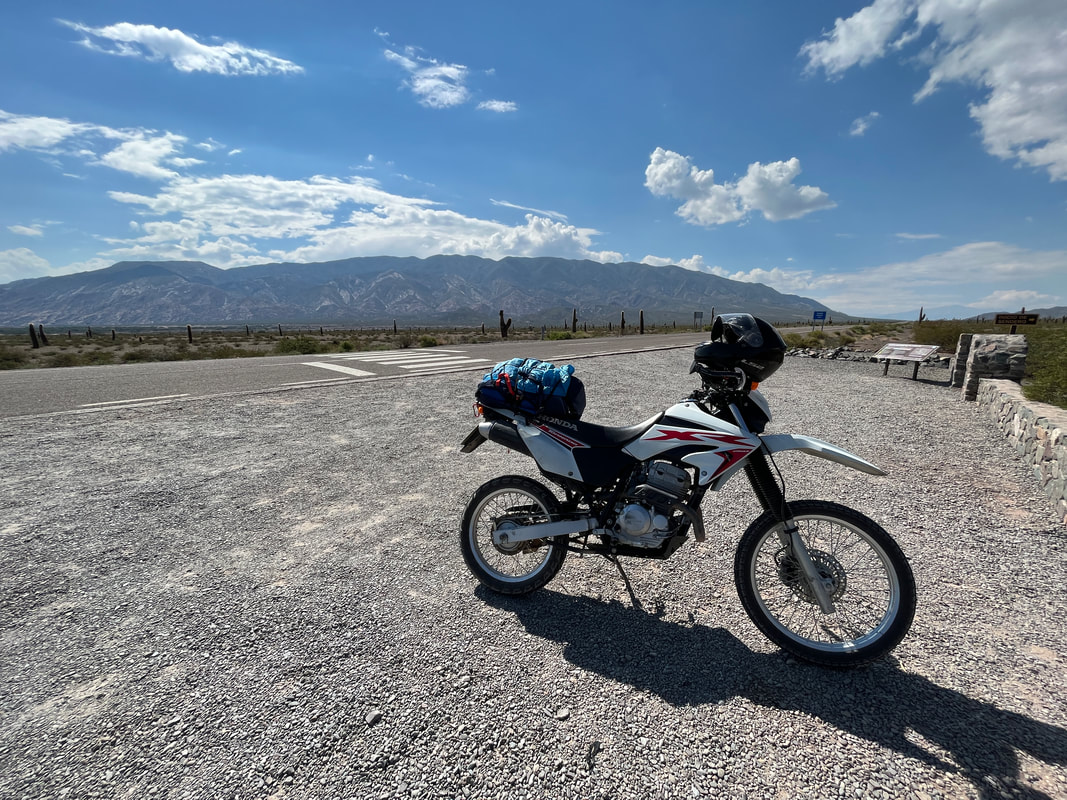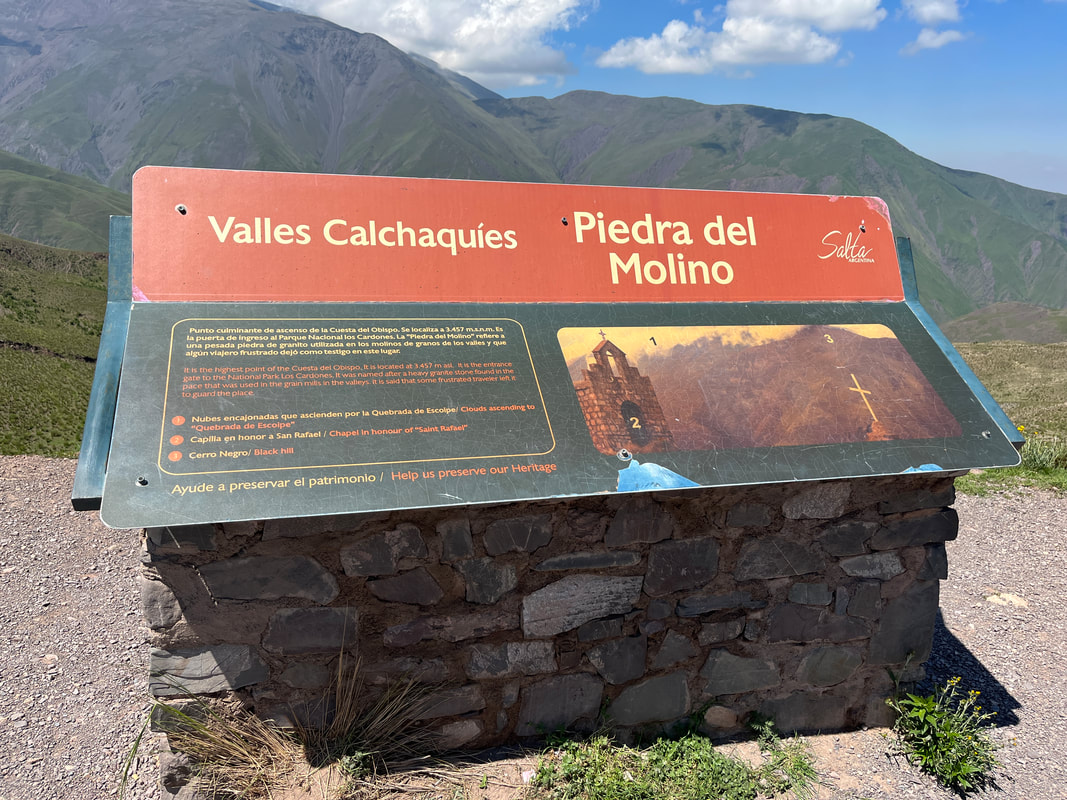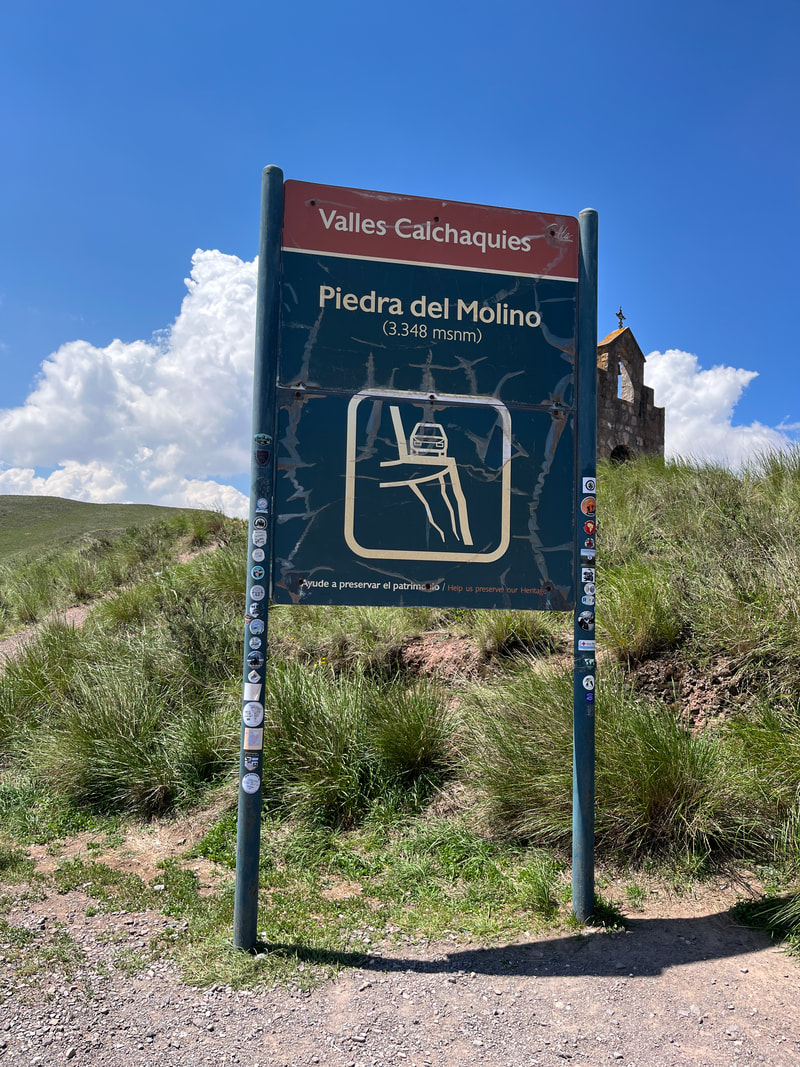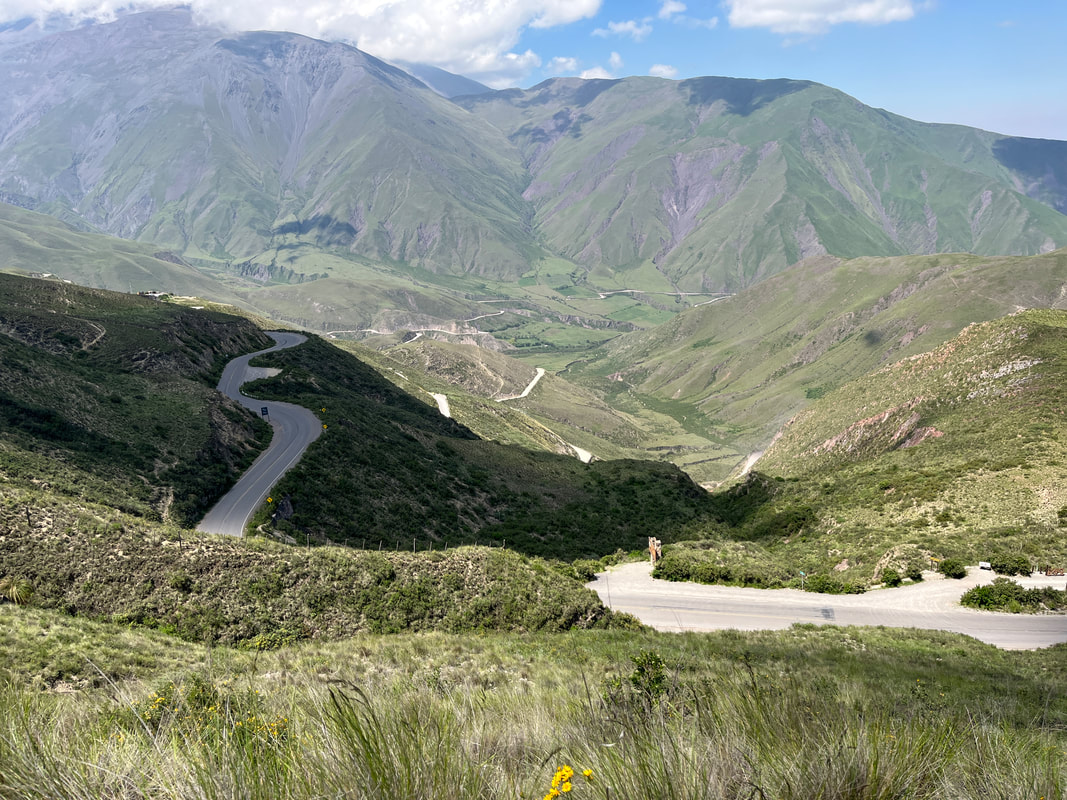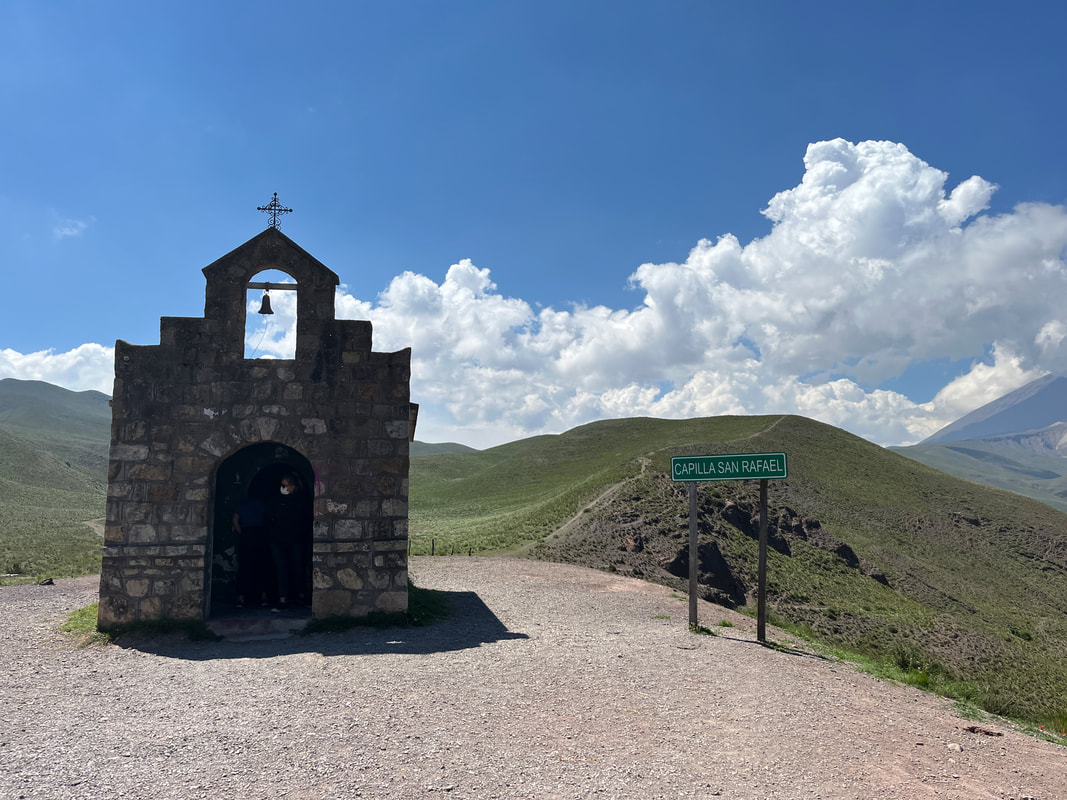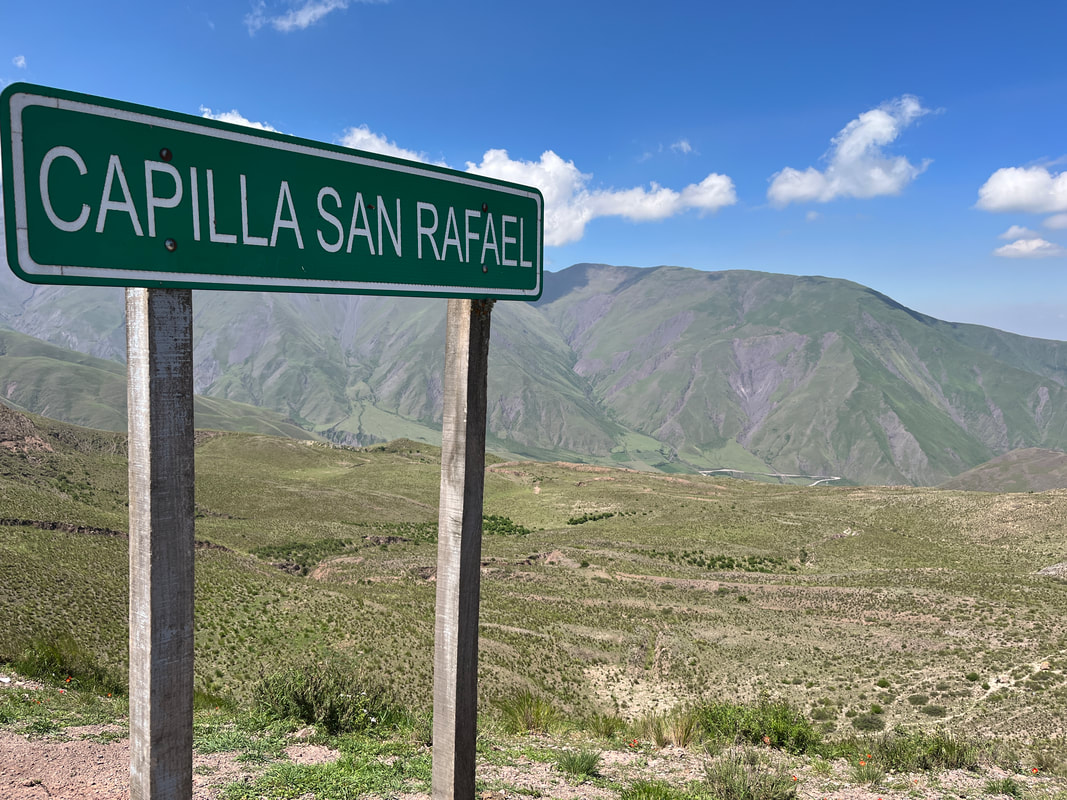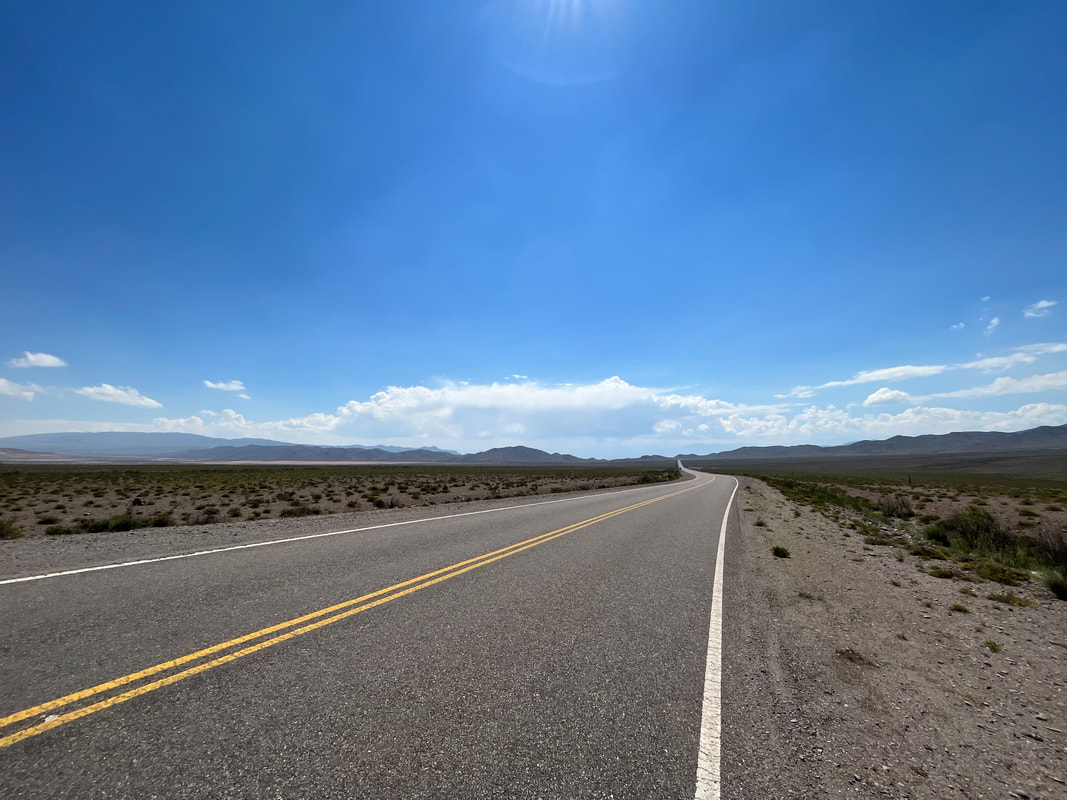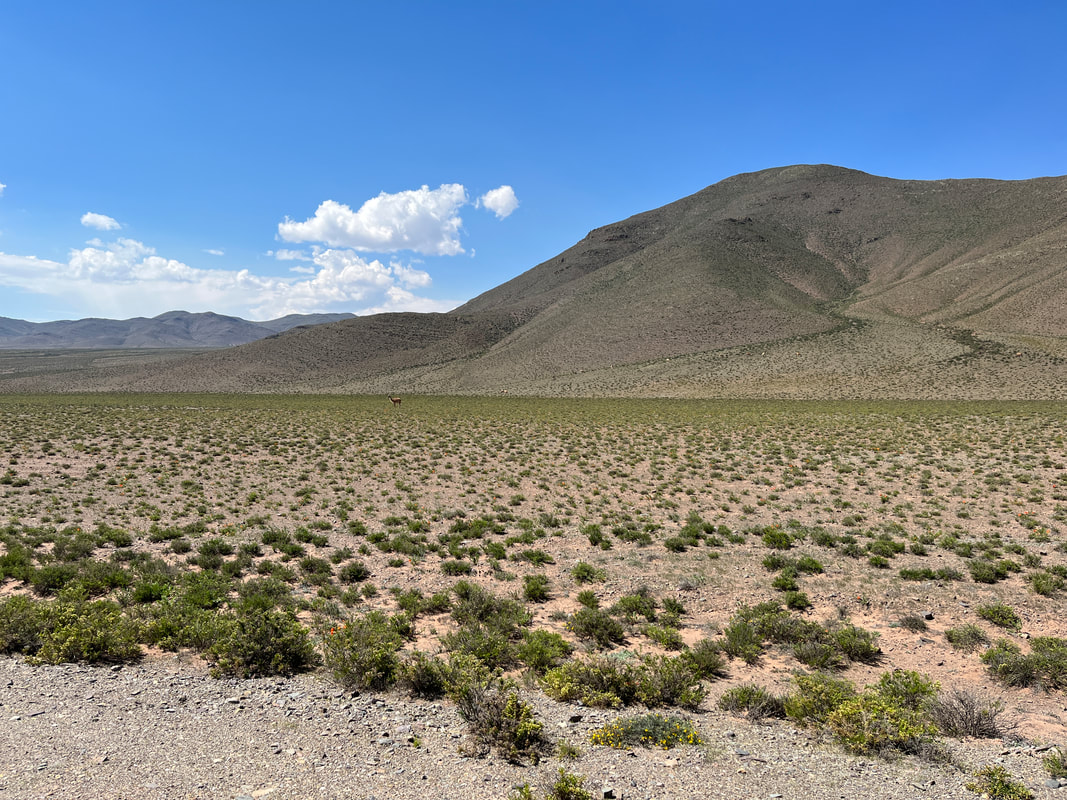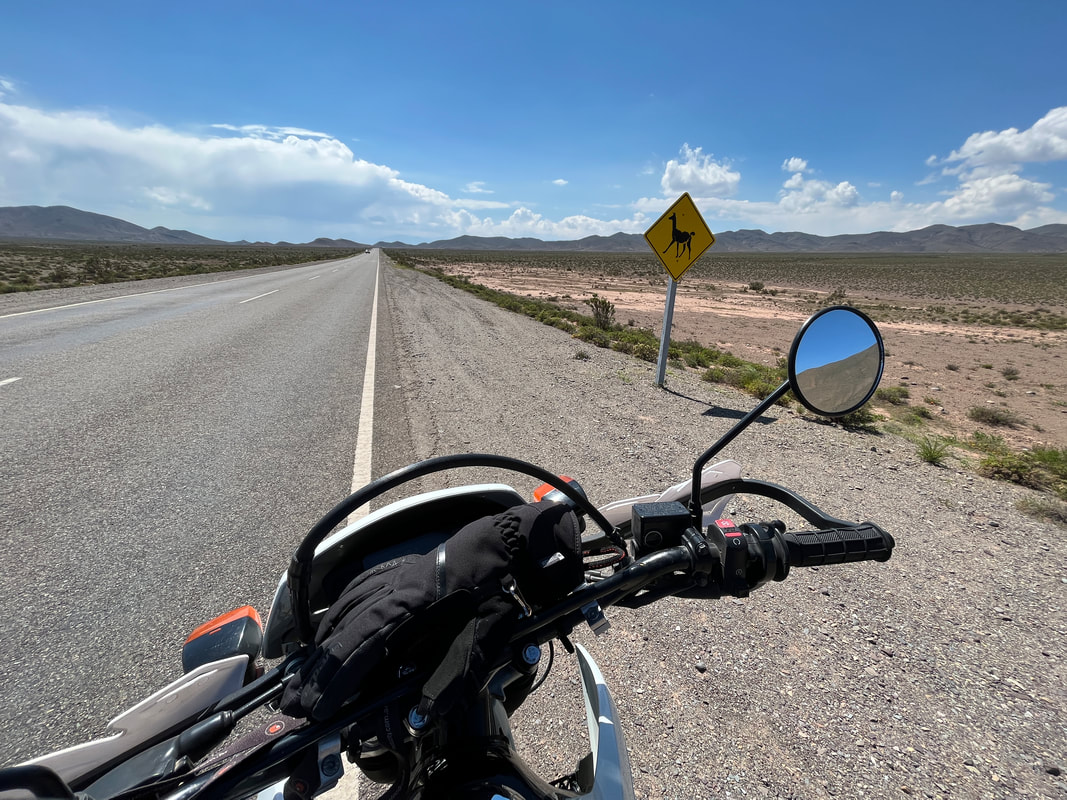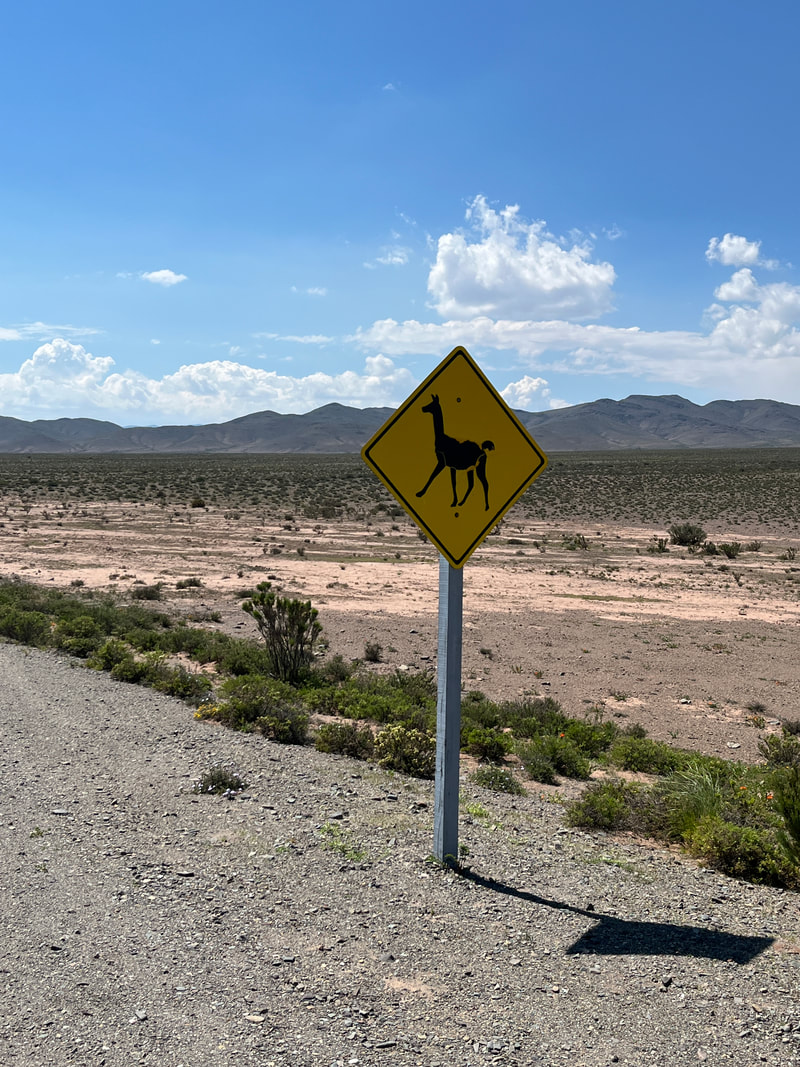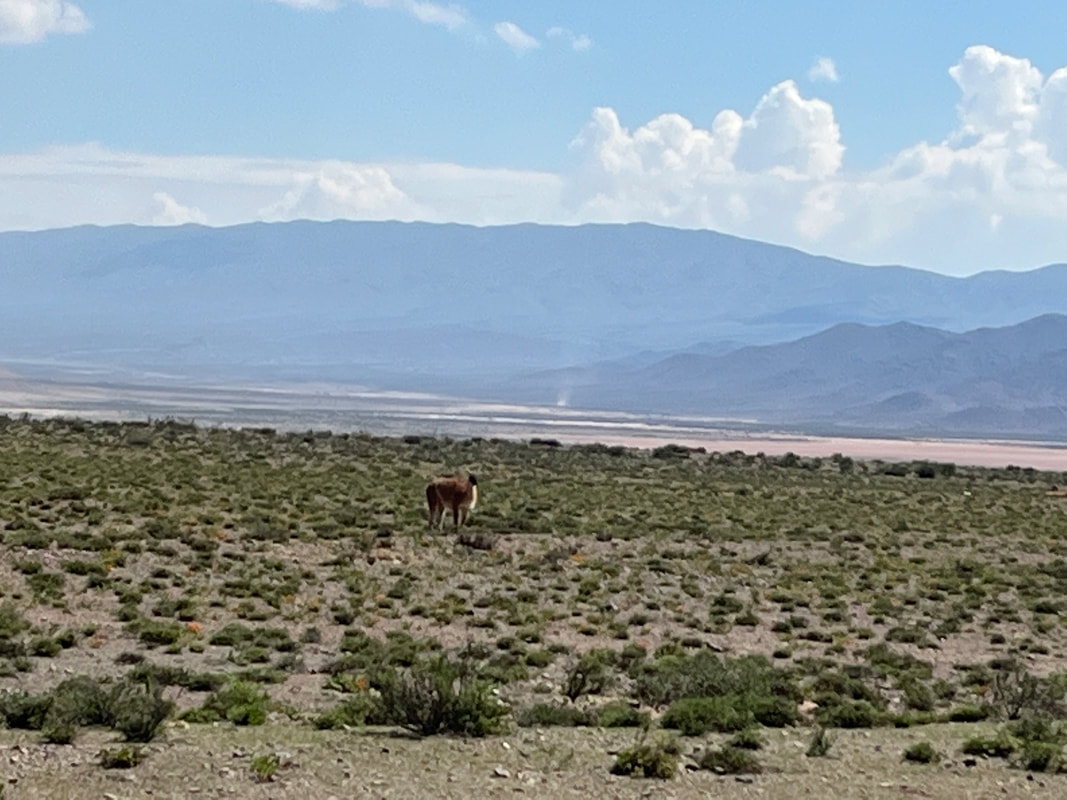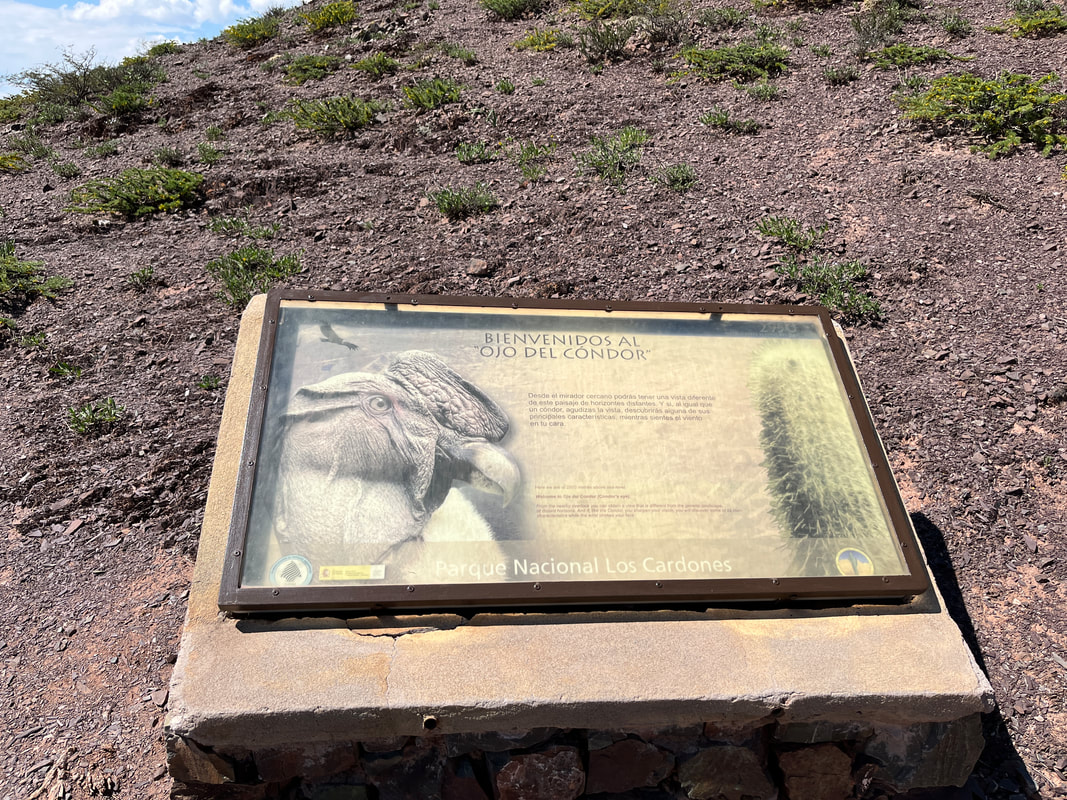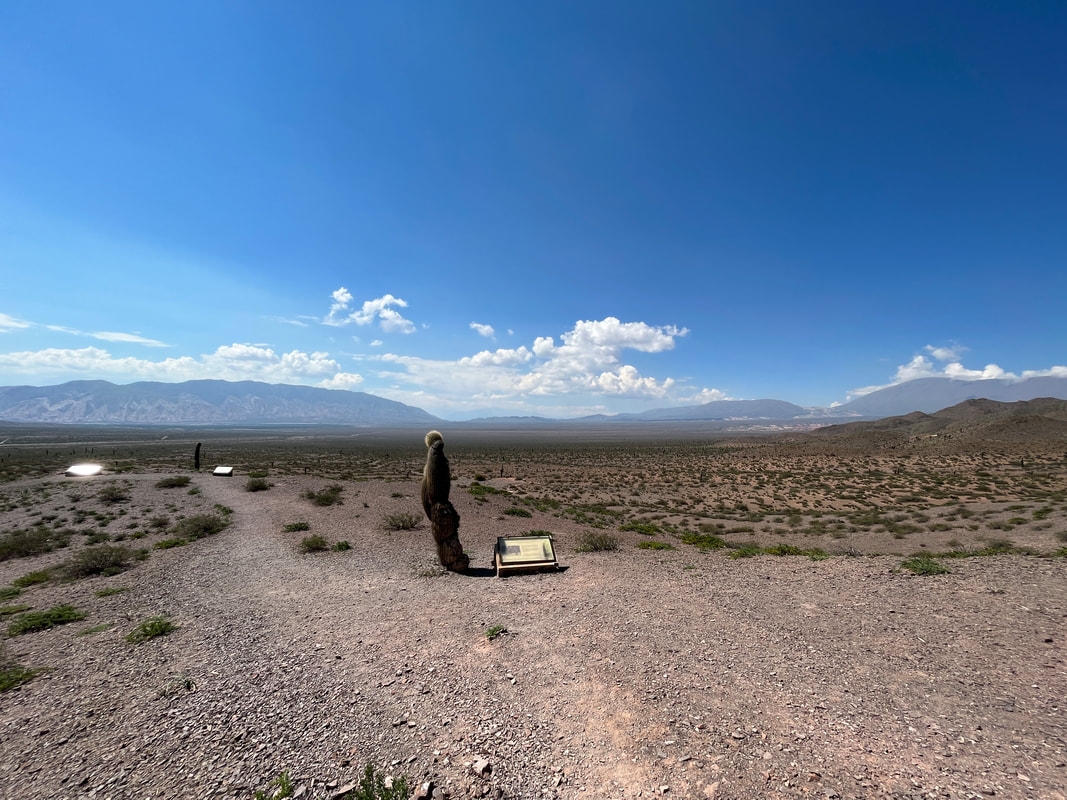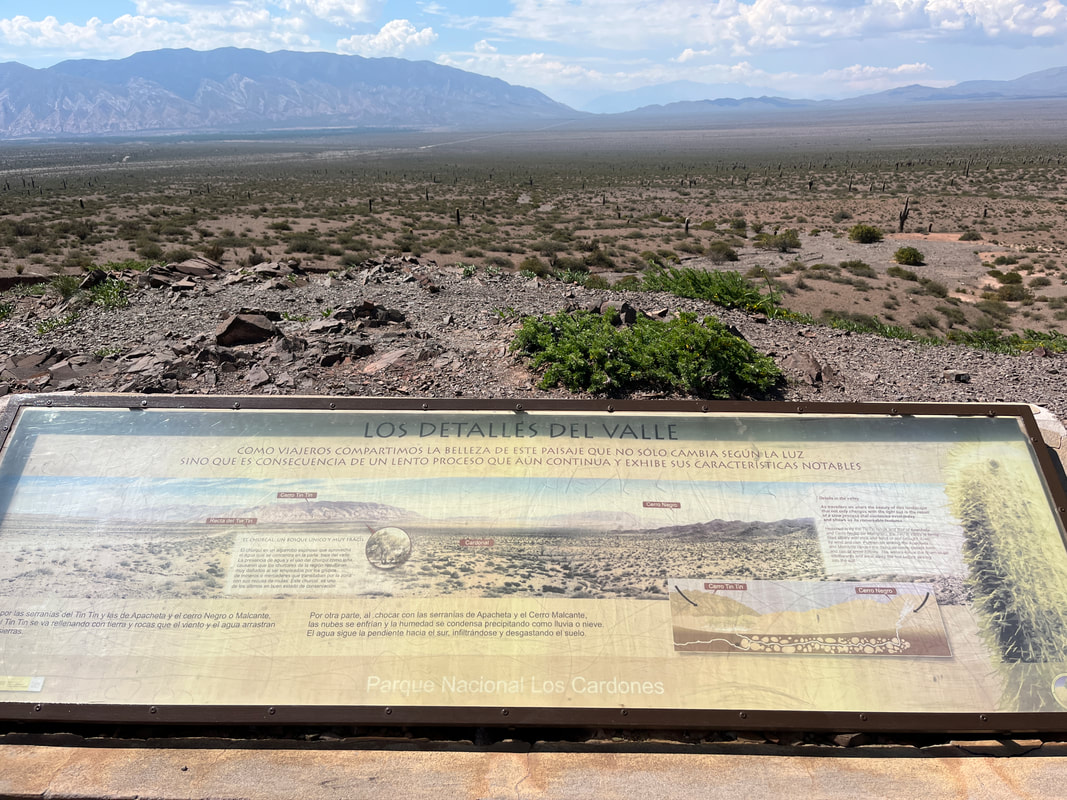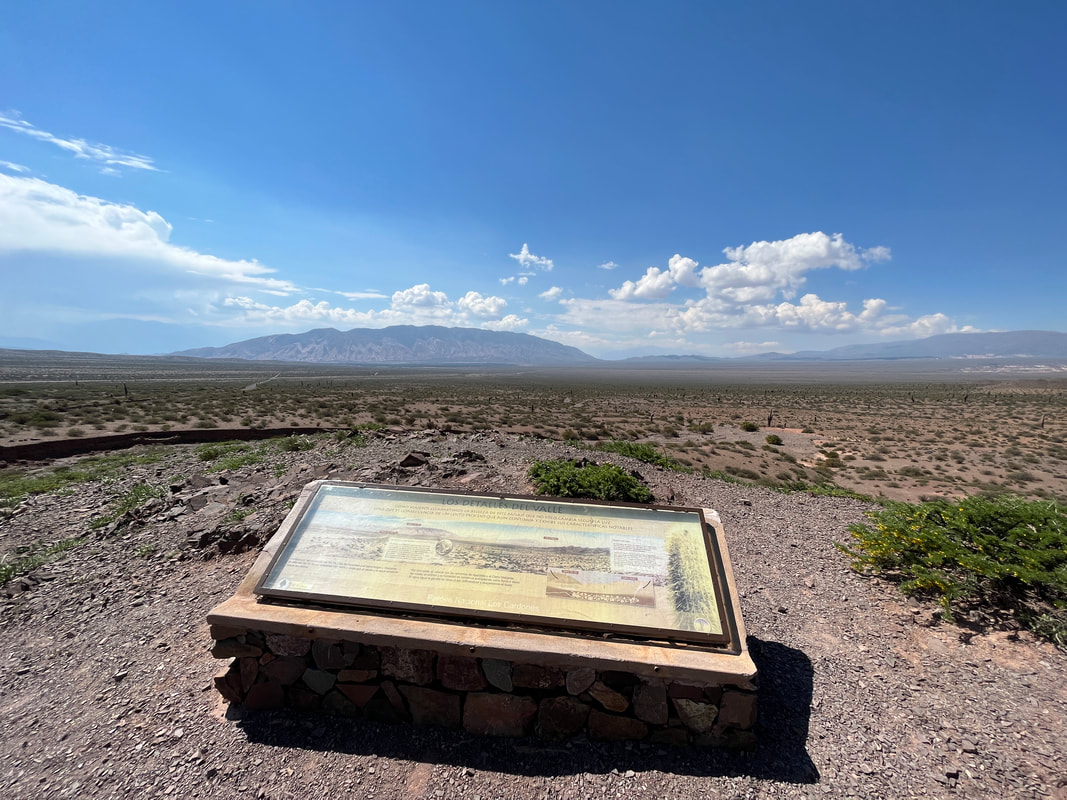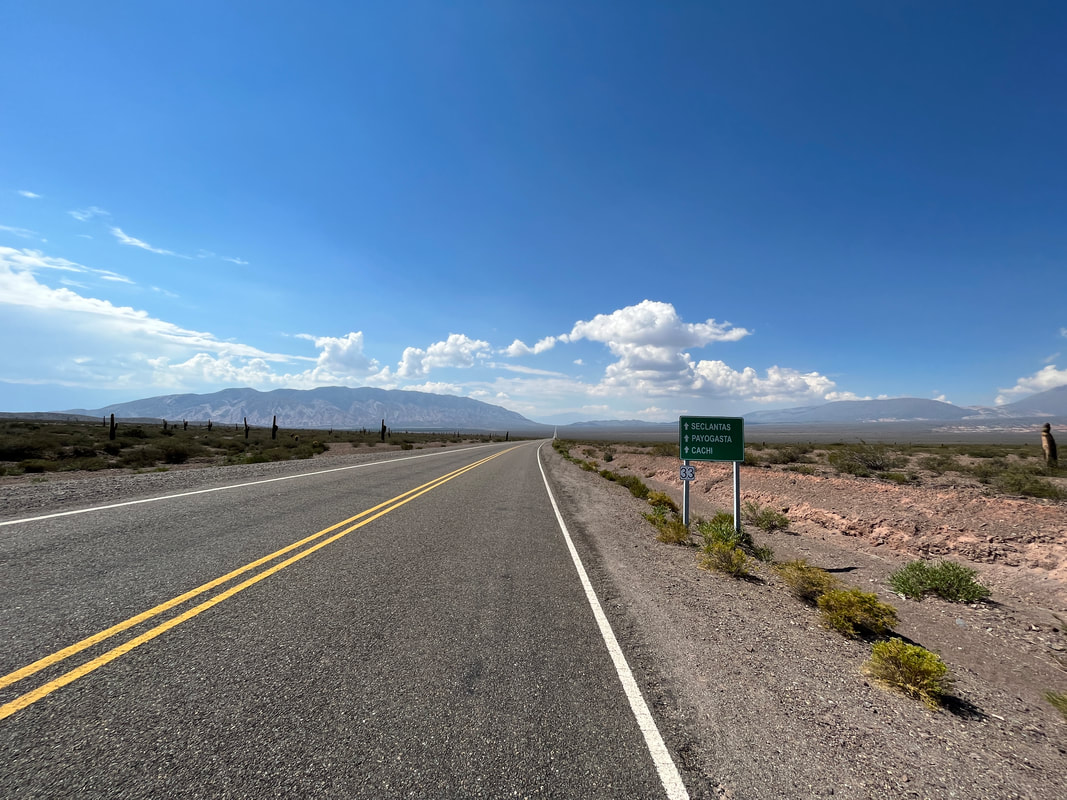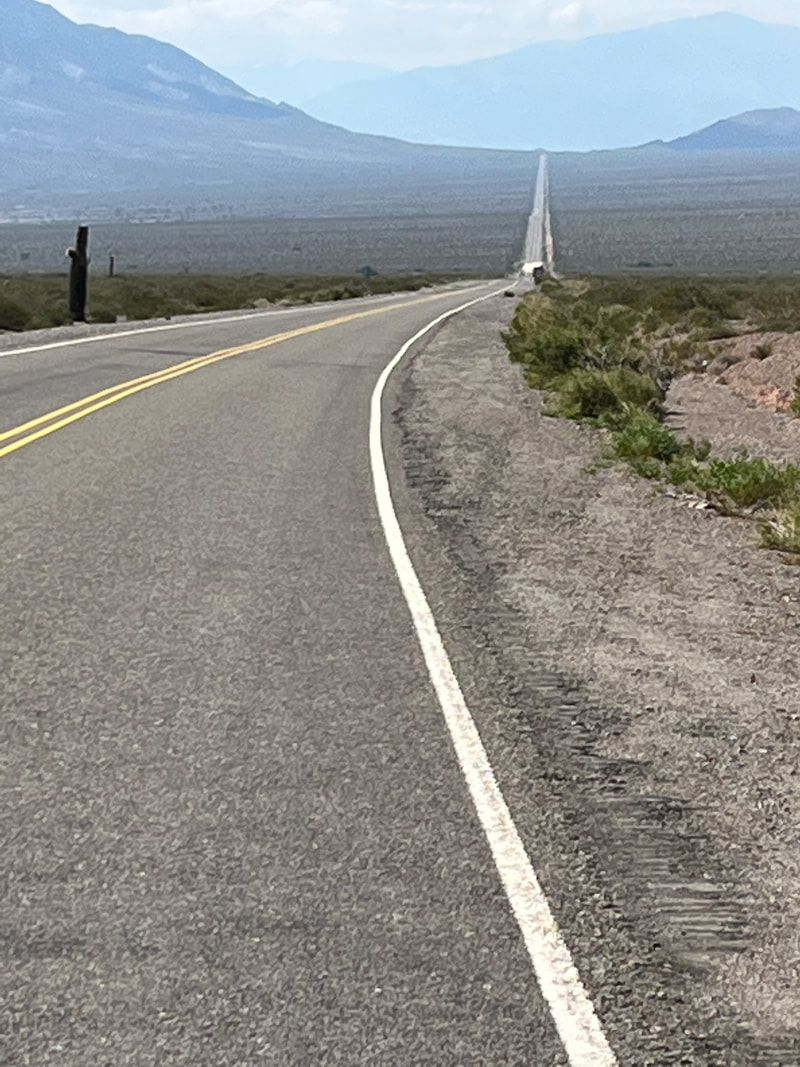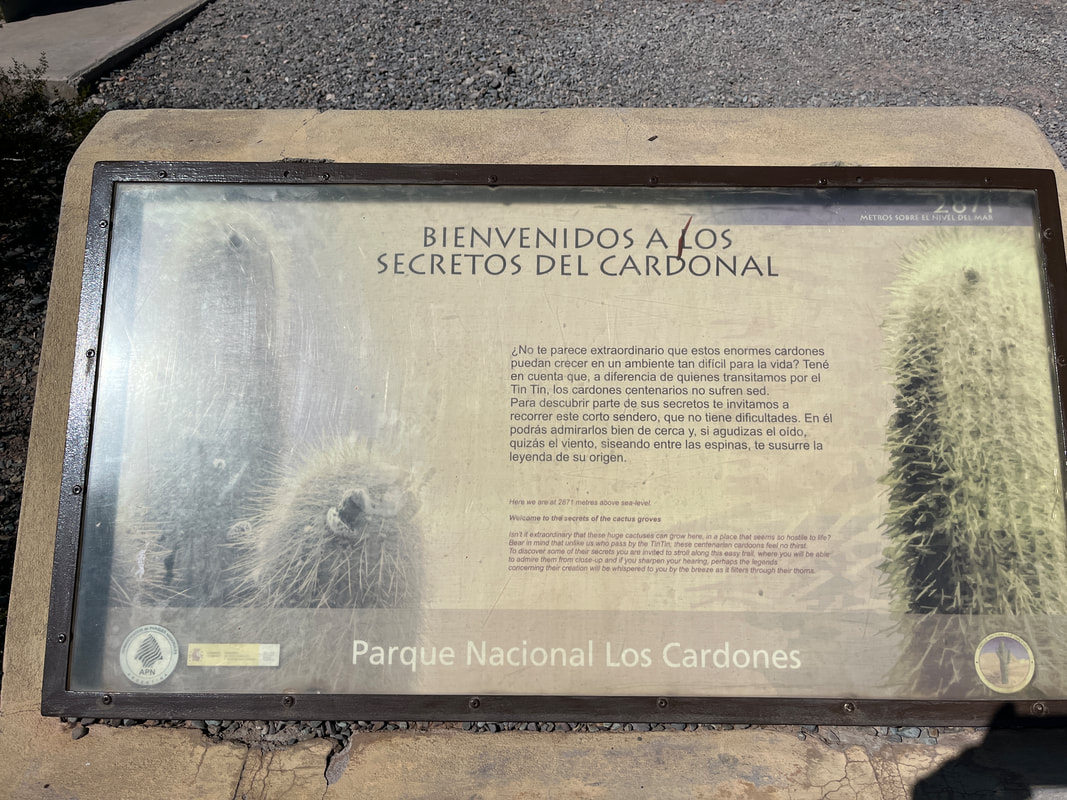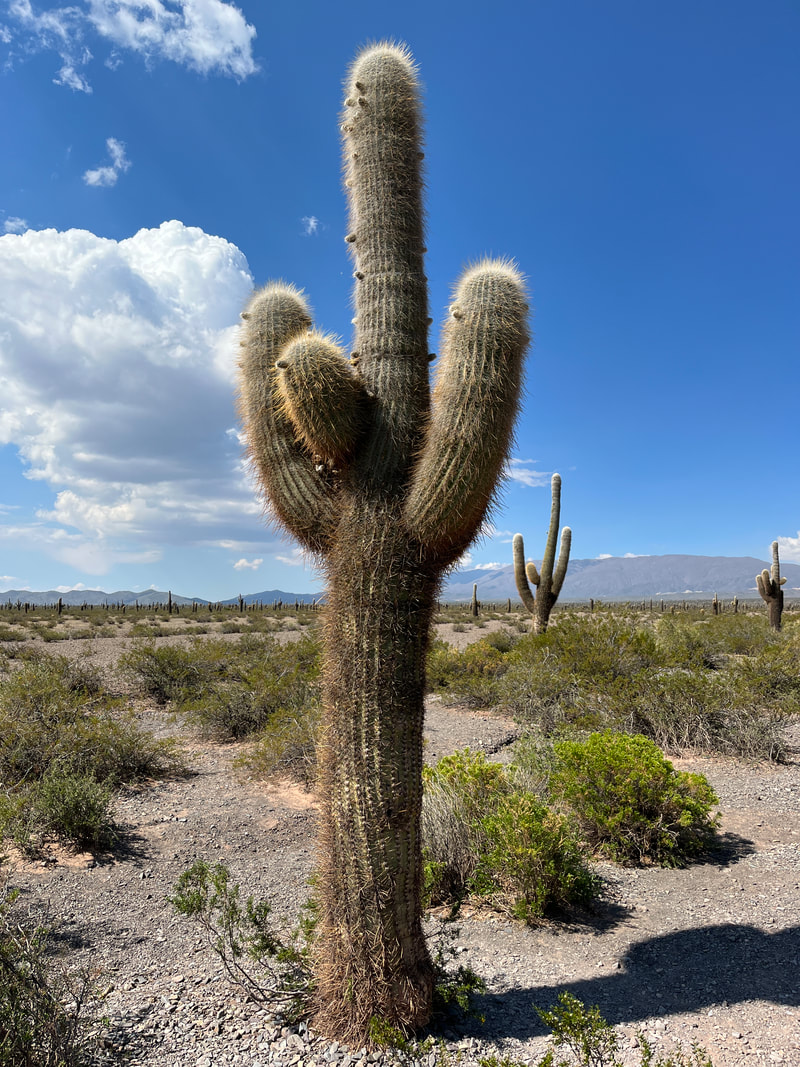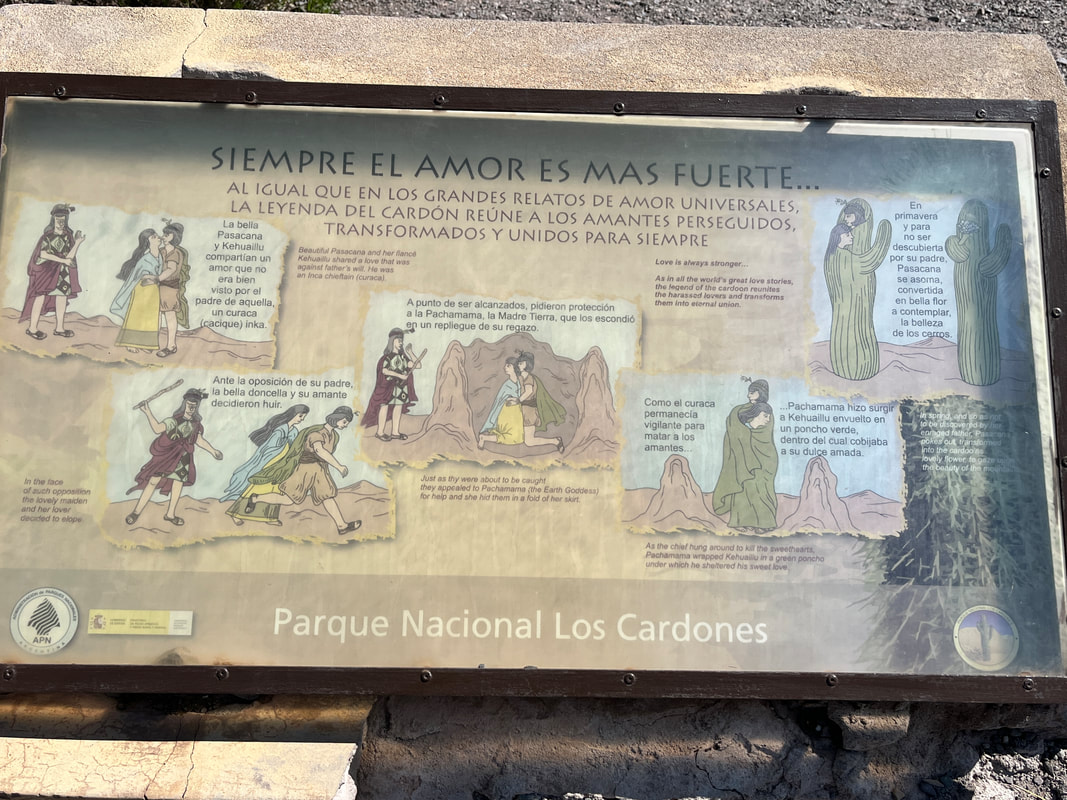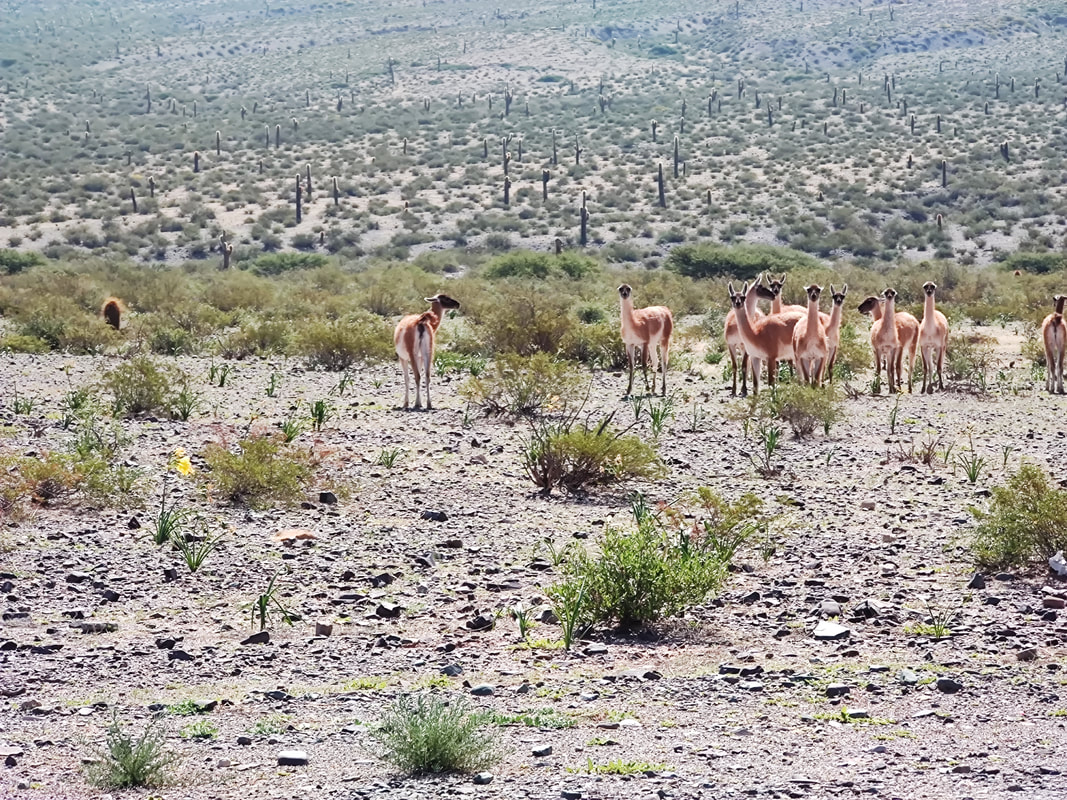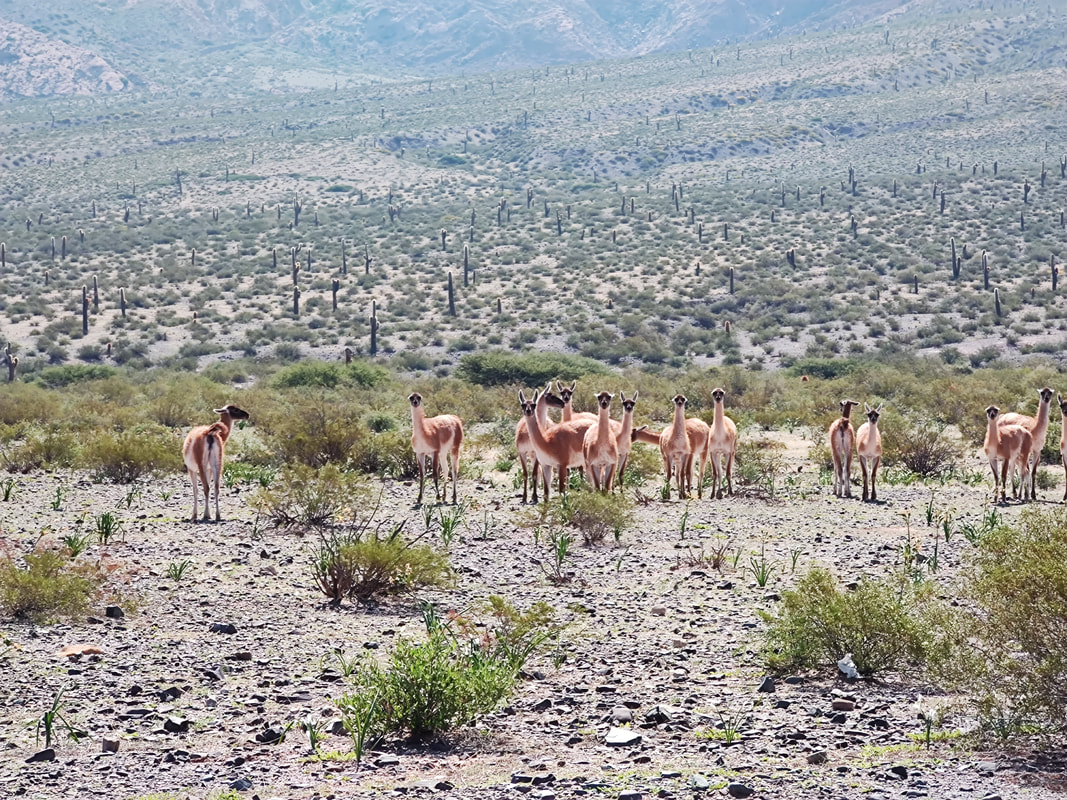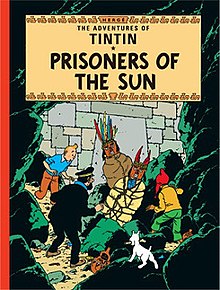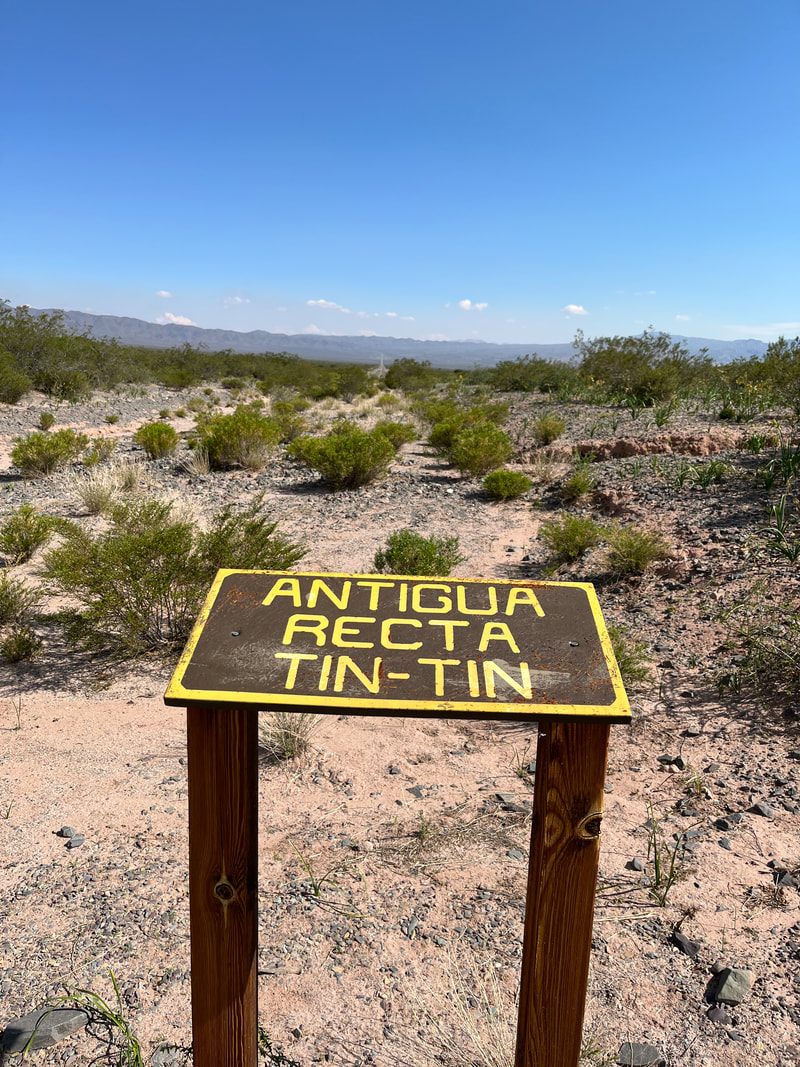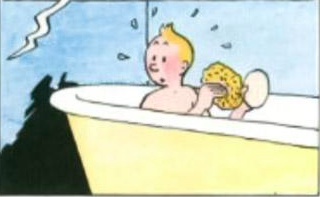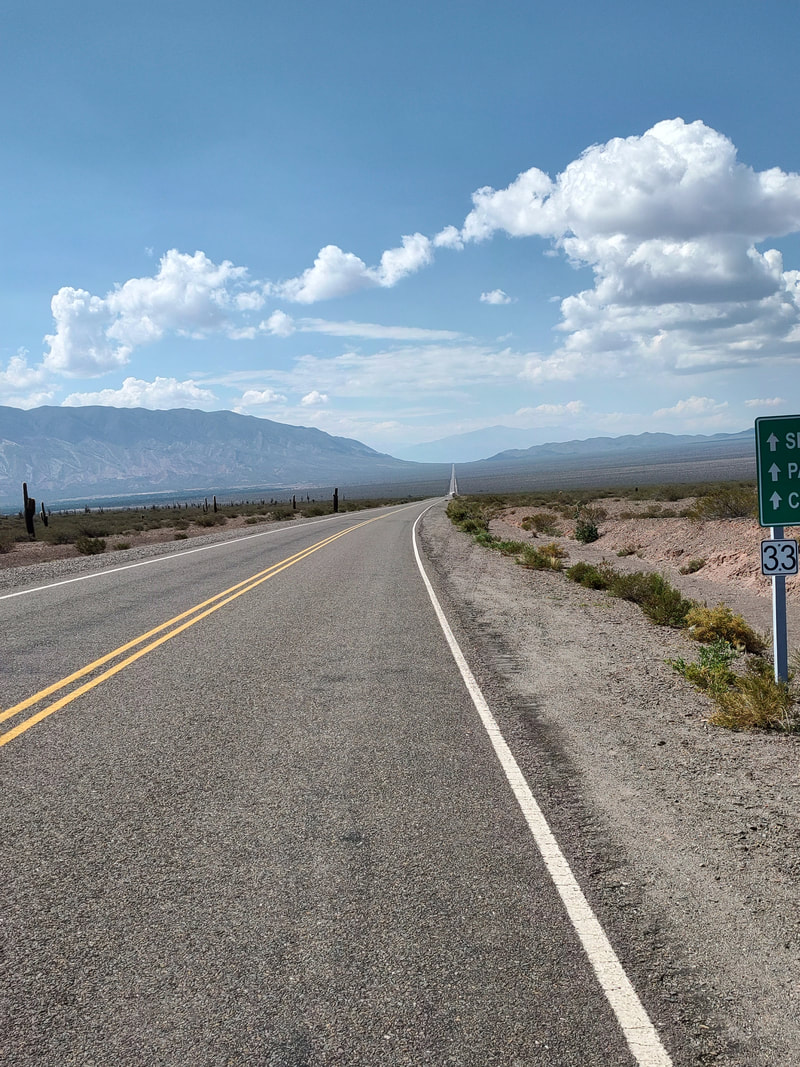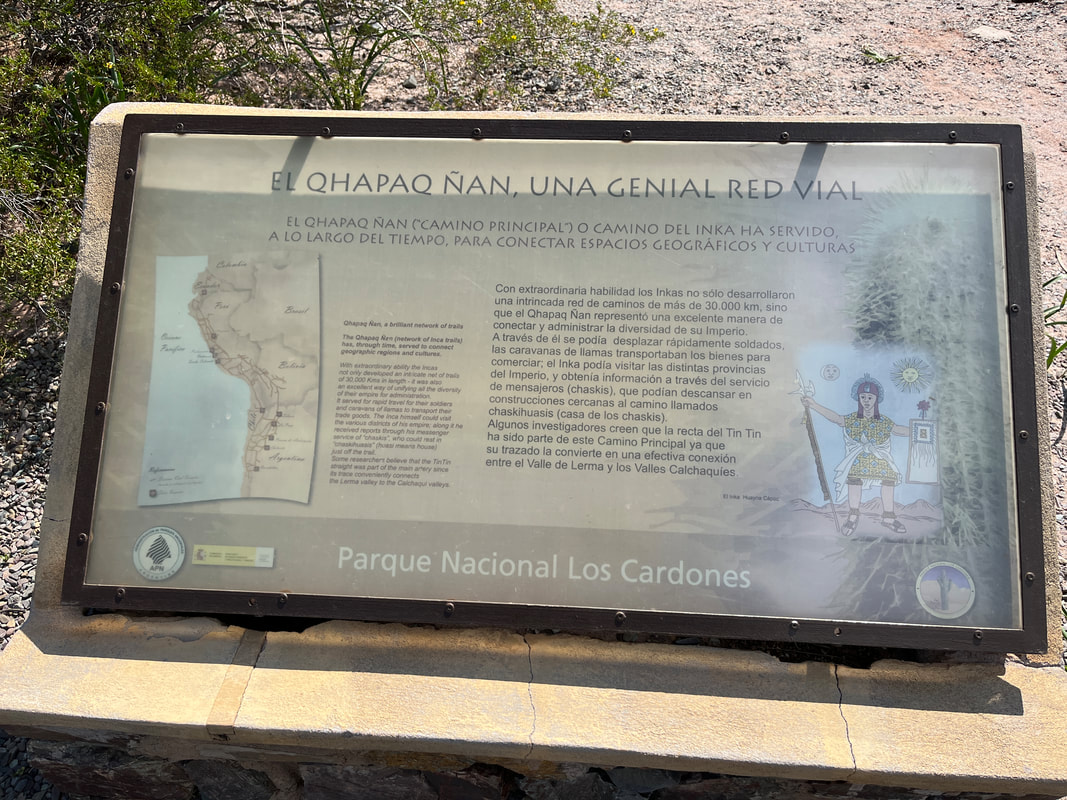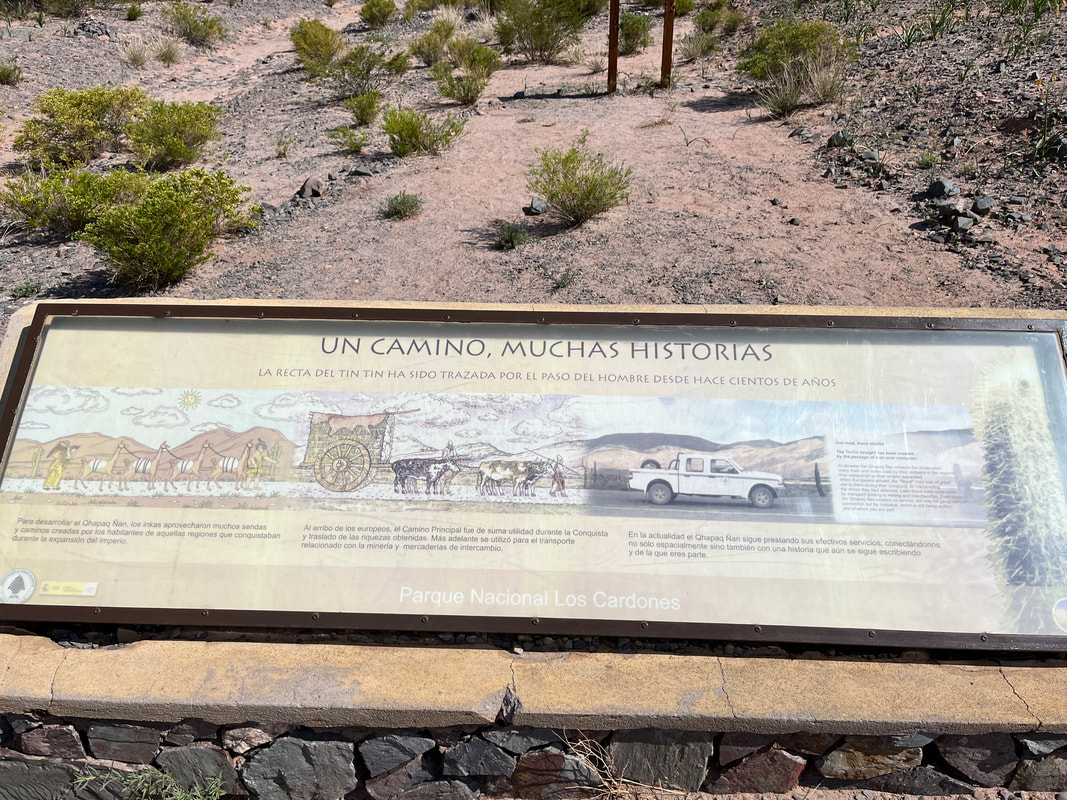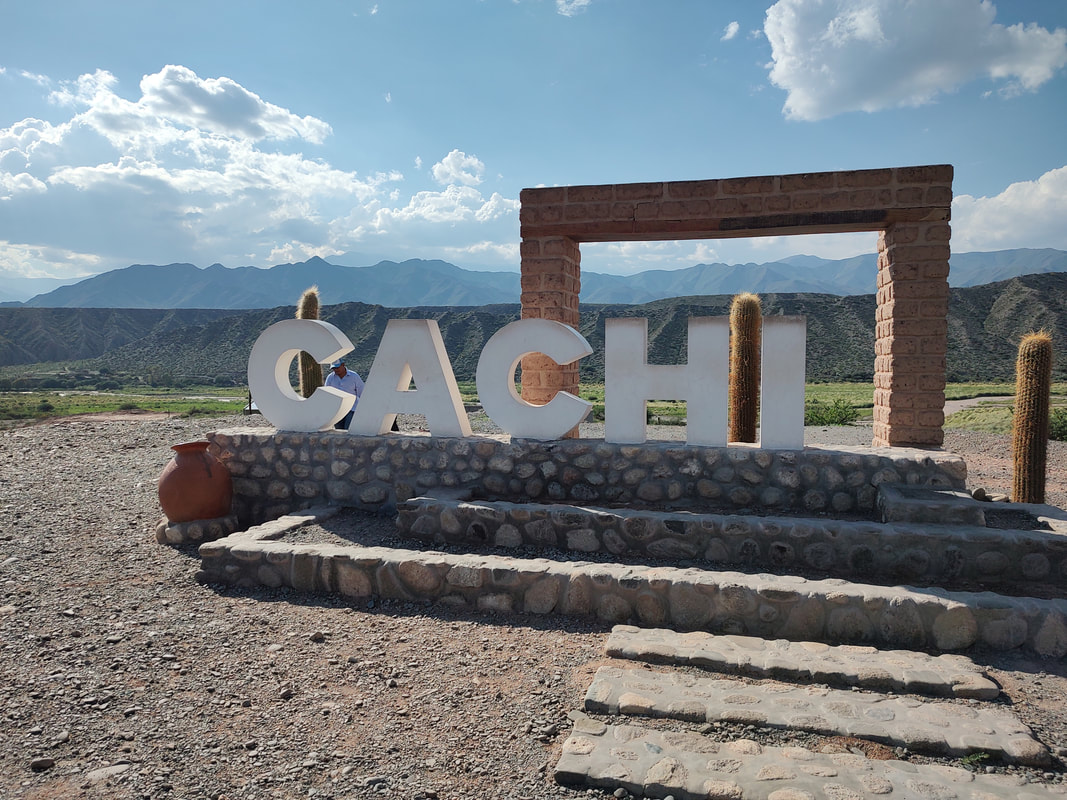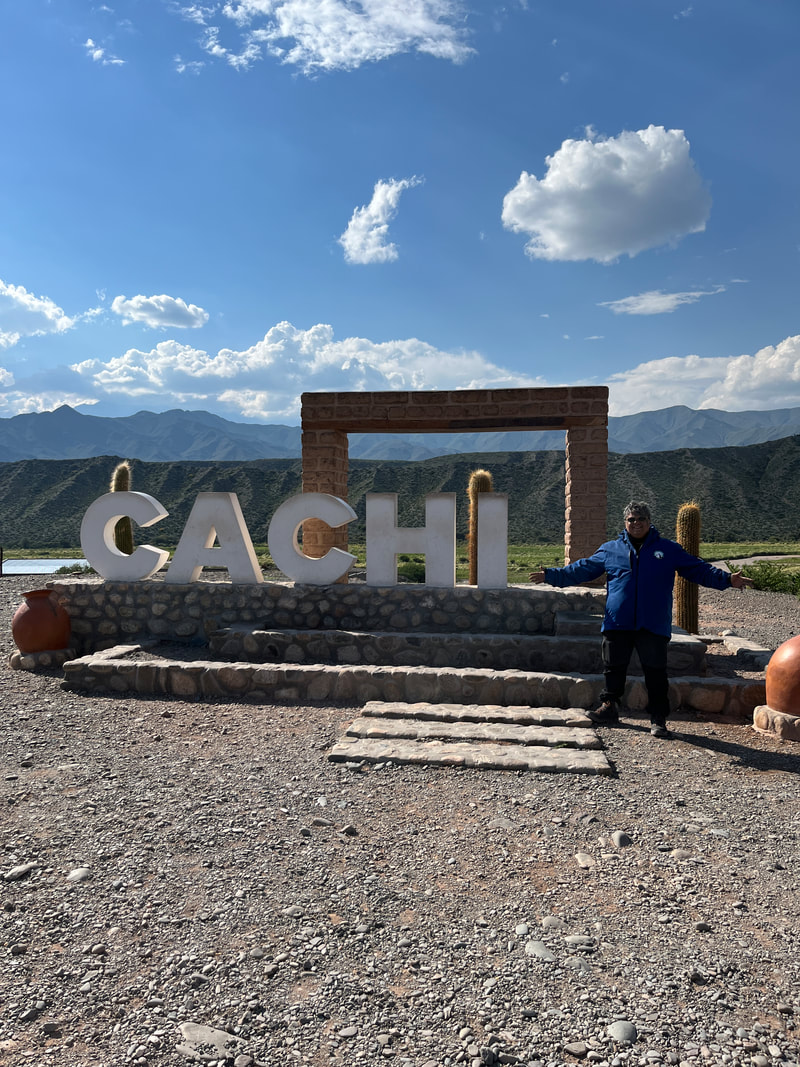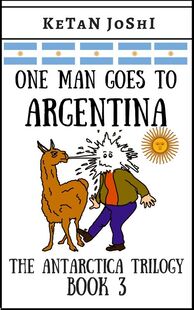Los Cardones national park
As I rode along that track - I suddenly saw a sign telling me that I was entering the ‘Parque Nacional Los Cardones’.
This national park takes its name from the ‘Cardón’ (the candelabra cactus), the park’s dominant plant species. In the treeless Andean foothills and puna, the cardón has long been an important source of timber for rafters, doors, windows and more. You'll see it often in the region’s traditional buildings.
they are cactus (Cacti? Cactuses?) - but very big ones! The cardon grande cactus or Argentine saguaro can grow over 7.6 metres (25 ft) tall! And they are found only in South America - and only in the Andes mountains. I love the English name too! The Candelabra cactus! It is so evocative! I can just imagine these beautiful tall plants in a lovely ball room, all adorned with candles!
And they have the most gorgeous flowers! It is so amazing to see a colourful flower sticking out of that most austere and forbidding looking giant thorny cactus. Imagine seeing one of those big thuggy bouncers on security detail outside a club, or mean-looking Hell’s Angel biker with a lovely flower tucked behind one ear!
I kept going up the twisties till I reached the very highest point of the trail!
It was called the Piedra del Molino - a high mountain pass at a very respectable elevation of 3457 meters above sea level. The road along the pass is known as Cuesta del Obispo - and this place is the highest point of this road.
It was called the Piedra del Molino - a high mountain pass at a very respectable elevation of 3457 meters above sea level. The road along the pass is known as Cuesta del Obispo - and this place is the highest point of this road.
Some super-enthusiastic people had built a chapel here! I wonder who comes here to pray? There is no civilisation around for miles! A few hundred meters before reaching the peak there is a lookout point where you can see the hairpins of the road, and it’s possible to have a lovely panoramic of the Quebrada del Escoipe.
What a view! If you want to feel close to God, you should step outside the chapel and see this view, and pray here while looking at God’s great creation.
What a view! If you want to feel close to God, you should step outside the chapel and see this view, and pray here while looking at God’s great creation.
I parked my bike and walked up to the chapel. ‘Capilla San Rafael’ the sign said - ‘The chapel of St Rafael’. Saint Raphael is considered the patron of travellers and happy meetings! That’s my kind of saint! How apt to have his chapel here - which will be visited by so many enthusiastic travellers.
The viewpoint looks down into the ‘Valles Calchaquíes’ - the Calchaquí Valleys - which are beautiful! What a contrast of geography- from the mountain desert to the subtropical forest!
The viewpoint looks down into the ‘Valles Calchaquíes’ - the Calchaquí Valleys - which are beautiful! What a contrast of geography- from the mountain desert to the subtropical forest!
I got back to my bike and started riding - now on a perfectly straight road! I seemed to have climbed on top of a high plateau and now was in the middle of a perfectly flat landscape, with views that stretched for miles!
And what views! A beautifully paved absolutely straight road cutting through the ‘High Monte’!
And what views! A beautifully paved absolutely straight road cutting through the ‘High Monte’!
The High Monte is a montane grasslands and shrub-lands ecoregion in Argentina.The High Monte is located on the eastern slopes of the Andes - It is a landscape of mountains and closed basins which lie between the Sierras Pampeanas mountains on the east and the main spine of the Andes to the west.
This is gorgeous high-desert territory, with rounded peaks crowning velvety mountains, where cactus groves stand tall at elevations that eclipse 3000m.
I was in heaven as I rode along this trail! I couldn’t make up my mind whether to ride slowly and enjoy the gorgeous views, or take advantage of the lovely smooth and empty road to really gun the bike and see what it could do!
This is gorgeous high-desert territory, with rounded peaks crowning velvety mountains, where cactus groves stand tall at elevations that eclipse 3000m.
I was in heaven as I rode along this trail! I couldn’t make up my mind whether to ride slowly and enjoy the gorgeous views, or take advantage of the lovely smooth and empty road to really gun the bike and see what it could do!
I could see bright yellow warning sign by the side of the road and I slowed down to see what it was warning me about - and it turned out to be a black silhouette of a llama on a bright yellow board. It was warning me about llamas crossing the road! How cool was that! I have seen signs about children crossing, trains crossing, sheep, elephants, deer … I had even seen kangaroo crossing signs in Australia - and now I was seeing a llama crossing sign!
I had to add this to my signs collection! I pulled out my phone to take a pic - and my eye was attracted to a movement in the scrubland. I peered at it - and it was actually a Llama! I laughed out loud in delight! HAHAHA - an accurate sign at last!
As I continued riding, I saw my first ‘Mirador’. A mirador is a viewpoint with a short interpretative trail, and is illustrated by signage. This park is full of them. Most cars and buses just zoom by them - but hey - I was alone on a bike. I am the master of my journey. I will stop wherever I feel like!
This first mirador was called the ‘Ojo del Condor’ - the ‘eye of the Condor’.
‘Here we are at 2950 metres above sea level. -Welcome to Ojo del Condor (Condor's eye)’ the sign said. ‘From the nearby overtook you can obtain a vow that is afferent from the general landscape of distant horizons. And if, like the Condor, you sharpen your vision, you discover some of its main characteristics while the wind strokes your face.’
Hmm… I am sure it sounds very literary and poetic in Spanish.
There was a small walk - and then you come to a magnificent landscape as the viewpoint overlooks the entire shrubby plateau below. What a sight! An endless landscape covered with small shrubs and dotted with tall Cordones - which must have looked a lot like giants with their arms akimbo!
This likeness to human beings once scared the pants off a priest walking here, as per the story written on a signboard. Father Juan de Leon was walking across this area in the 15th century and he must have got overwhelmed by the altitude and solitude and tiredness - and was convinced that the Cordones were actually a band of Indians who were following him and were going to kill him!
‘Here we are at 2950 metres above sea level. -Welcome to Ojo del Condor (Condor's eye)’ the sign said. ‘From the nearby overtook you can obtain a vow that is afferent from the general landscape of distant horizons. And if, like the Condor, you sharpen your vision, you discover some of its main characteristics while the wind strokes your face.’
Hmm… I am sure it sounds very literary and poetic in Spanish.
There was a small walk - and then you come to a magnificent landscape as the viewpoint overlooks the entire shrubby plateau below. What a sight! An endless landscape covered with small shrubs and dotted with tall Cordones - which must have looked a lot like giants with their arms akimbo!
This likeness to human beings once scared the pants off a priest walking here, as per the story written on a signboard. Father Juan de Leon was walking across this area in the 15th century and he must have got overwhelmed by the altitude and solitude and tiredness - and was convinced that the Cordones were actually a band of Indians who were following him and were going to kill him!
Other people loved the cardones - and a poet from Salta wrote
High up there blooms
the Cactus Flower
amid the spines
and wind and sun.
Chalice of gold and mother-of-pearl
(Oh) generous blossom,
Candy for the honeybees,
the Cactus Flower!
High up there blooms
the Cactus Flower
amid the spines
and wind and sun.
Chalice of gold and mother-of-pearl
(Oh) generous blossom,
Candy for the honeybees,
the Cactus Flower!
There were a lot of miradors telling us more about the wonders of these great Cardones - one mirador invited you inside a whole grove of them and there was a sign telling you how these giant plants are a result of pretty fancy evolution - how they store water in their tissues like great barrels, how the leaves have become thorns to lower evaporation and provide protection, the skin is waxy and thick - and they have two types of roots! One which sis near the surface to pick up water from condensation and dew, and deep tap roots which hunt for underground rivers.
And there was even a legend about the origin story - the usual one about lovers with angry parents , who ran away into the desert to escape from said uncool pop - in this case, the Inca chieftain, or ‘curaca’. And just as pop was about give the chop - they prayed to the earth goddess Pachamama, who wrapped them in her green poncho and turned them into invulnerable Cardones- leaving the frustrated papa cursing and gnashing his teeth.
Just as I was thinking these sombre thoughts - I saw a movement in the shrubs. And there was a whole herd of Guanaco! A whole herd! At least 20 of them! And they were so close I could see their faces and expressions
Wow! What a rush!
I gasped - and they all pricked up their ears and looked at me inquiringly. ‘Yes?’ they seemed to be saying politely. ‘Is there something we can do for you?’
Wow! What a rush!
I gasped - and they all pricked up their ears and looked at me inquiringly. ‘Yes?’ they seemed to be saying politely. ‘Is there something we can do for you?’
I was delighted to find that the valley I was seeing was called the ‘TinTin valley’! ‘Tintin the reporter’ is a character created by the Belgian cartoonist ‘Herge’. He is the star of a whole series of comic books about his adventures all over the world - ‘The adventures of Tintin’. My first love for South America started when I read about his adventures in South America in the epic ‘The prisoners of the sun’. Herge’s magnificent illustrations really lit a fire in my mind.
I have no idea why it was called the ‘Tintin valley’ - but I was even more amused to see that it was called the ‘Recta TinTin’.
It had nothing to do with Tintin’s rectum, of course…
It had nothing to do with Tintin’s rectum, of course…
It just meant that this was a straight road through the Tintin valley. The Recta Tintin is a super-straight stretch of road that extends for about 11 miles (18 km) along a seemingly perfectly flat plateau dotted with giant cardón cacti.
‘Recta’ comes from the Latin word ‘Rectus’ - which means ‘straight’
Fun fact - the words ‘Rectum’, ‘Rector’ and ‘Erection’ all come from a single root - Rectus, meaning ‘straight’.
‘Recta’ comes from the Latin word ‘Rectus’ - which means ‘straight’
Fun fact - the words ‘Rectum’, ‘Rector’ and ‘Erection’ all come from a single root - Rectus, meaning ‘straight’.
The last mirador was the most interesting one for me - because it pointed out that this road - the super straight recta Tintin - actually a road of great antiquity and historical significance. This was part of the ‘Qhapaq Ñan’ - a network of ancient Inca trails which served to connect the Inca empire.
The Inca road system (the Qhapaq Ñan meaning "royal road" in Quechua) was the most extensive and advanced transportation system in pre-Columbian South America. It was apparently 40,000 kilometres (25,000 mi) long! What an awesome feat of engineering! It can be directly compared with the road network built during the Roman Empire - the Inca road system was built a thousand years later. The road system allowed for the transfer of information, goods, soldiers and persons,, within the Tawantinsuyu or Inca Empire throughout a territory of almost two million square kilometres and inhabited by about 12 million people. And remarkable this was done without the use of wheels! For some reason, the South American civilisations never got around to using wheeled vehicles for transport.
The Inca road system (the Qhapaq Ñan meaning "royal road" in Quechua) was the most extensive and advanced transportation system in pre-Columbian South America. It was apparently 40,000 kilometres (25,000 mi) long! What an awesome feat of engineering! It can be directly compared with the road network built during the Roman Empire - the Inca road system was built a thousand years later. The road system allowed for the transfer of information, goods, soldiers and persons,, within the Tawantinsuyu or Inca Empire throughout a territory of almost two million square kilometres and inhabited by about 12 million people. And remarkable this was done without the use of wheels! For some reason, the South American civilisations never got around to using wheeled vehicles for transport.
I kept going along the road - and suddenly I saw one of the ‘selfie points’ which have become so ubiquitous worldwide. You know - the name of the town in giant letters, and you stand in front of it and take selfies. They call it a ‘Cartel’ out here.
A car rolled up just as I dismounted and the good-looking couple greeted me with a curious look and a cheerful ‘Hola’. Their good manners prevented them from directly questioning a perfect stranger - but she managed to break the ice by offering to take my photo for me. And now since the ice had been broken, we started chatting - and she was quite taken aback to find that I was from India!
‘Oh my god - I thought that it was a long flight getting here from Buenos Aires!’ she cried ‘How did you manage to get here from India?’
‘Oh my god - I thought that it was a long flight getting here from Buenos Aires!’ she cried ‘How did you manage to get here from India?’

